As we progress further into the digital age, the electronic components we use to create our devices have become vitally important. At the heart of each of these devices – whether it’s our mobile phones or our fridges – are semiconductors.
Semiconductors are the silent heroes of the electronic world, facilitating the flow of electricity through a device. Considering the importance of semiconductors to our digital world, their meteoric market revenue increase since 1987 is hardly surprising.
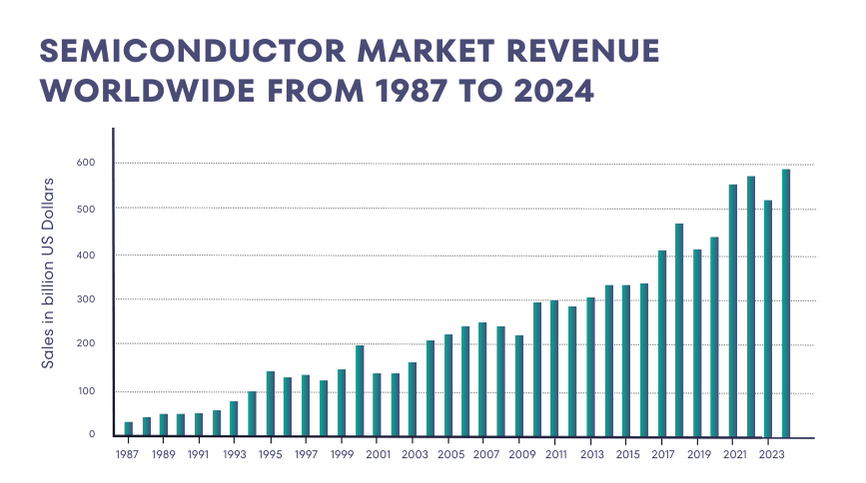
Source: Semiconductor market revenue worldwide from 1987 to 2024
The continual improvement of the semiconductor supply chain has been vital to the success of this industry. The semiconductor supply chain involves procuring the raw materials to develop semiconductors, creating them in factories, and distributing them across the globe.
Countries like China, the United States, Japan, and Malaysia regularly export over $9 billion USD worth of semiconductors, with the former entries exporting over $60 billion equivalent in semiconductors each year.
Understanding global shifts, changing demand levels, and emerging production trends is critical to the success of players in this industry. In this article, we’ll explore the future of semiconductors, trace their global supply chain, and comment on semiconductor trends.
Semiconductor Industry Landscape
The semiconductor industry encompasses the design, production, distribution, and usage of semiconductor components. Semiconductors, sometimes called ICs (Integrated Circuits) or chips, are fundamental to the functioning of modern technology. These small yet powerful chips facilitate the storage, transmission, reception, and processing of electronic signals.
Organisations craft semiconductors from various pure elements, like germanium and silicon, compounds, like gallium arsenide, and trace impurities that increase the material’s conductivity.
The expansion of the semiconductor industry has paralleled the vast increase in the usage of electronic devices over the past three decades.
However, 2023 was a difficult year for the semiconductor industry. Across 2023, the industry generated sales worth $520 billion, a slight reduction of 9.4% from previous years. Yet, despite a challenging 2023, things are already looking up in 2024.
Forecasts predict that global sales in the semiconductor sector will reach $613 billion in 2024. This figure would represent a 17.88% increase from 2023. Beyond bouncing back from 2023, this would also make 2024 a new record year, surpassing the $574 billion achieved in 2022.
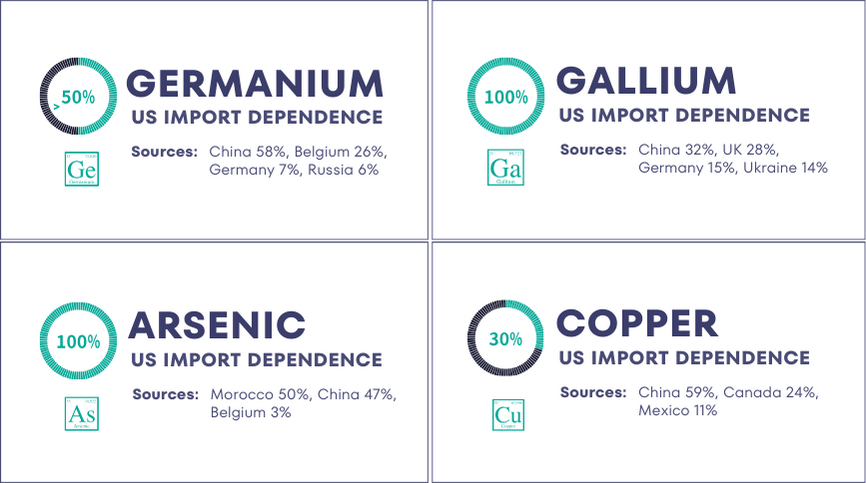
Source: Raw materials for semiconductors and their source location.
Semiconductor production by country
The semiconductor industry has a global reach, with countries around the world developing their own leading handful of semiconductor suppliers. Semiconductors are actually one of the United States’ top exports, demonstrating their value to electronics manufacturers everywhere.
Yet, despite their prevalence in the USA, this is far from the only place that produces and exports semiconductors. The countries that produce the most semiconductors are:
- Taiwan – Taiwan is home to the Taiwan Semiconductor Manufacturing Company, which produces around 50% of the world’s semiconductors.
- South Korea – Home to Samsung and companies like SK Synix, semiconductors account for around 15% of the country’s exports.
- Japan – Japan’s government set aside around $7 billion USD to build new semiconductor manufacturing plants across 2021 and 2022.
- United States – The United States was a world leader in the 1990s for semiconductor production, but now accounts for under 8% of the total.
- China – China has the capacity to produce around 22% of all semiconductors, based on the total amount of factories they list.
Different bodies of statistics interchange Taiwan and South Korea as the world’s leaders. These countries routinely trade places as market leaders and have done so since the early 2010s.
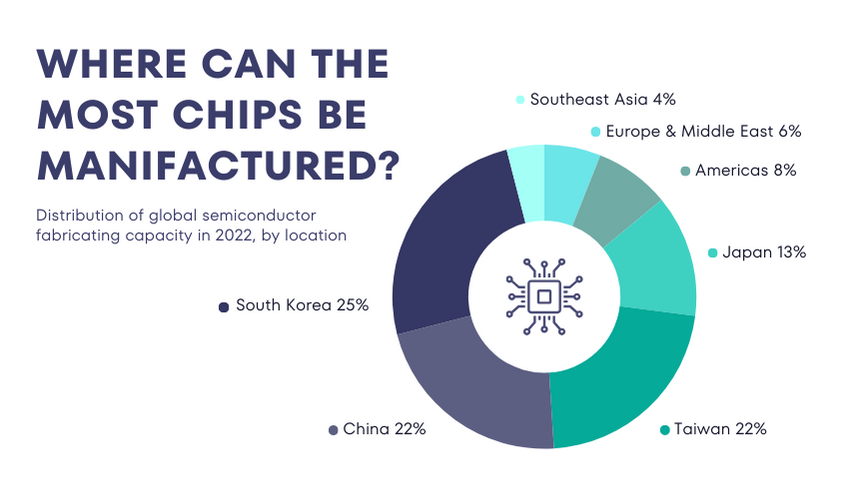
Source: Distribution of global semiconductor fabricating capacity.
Key semiconductor suppliers
Many of the countries above have only become so famous for the production of semiconductors due to a select handful of companies that operate in their areas. For example, Samsung accounts for a large portion of South Korea’s total semiconductor exports.
Here are a few of the biggest players in the semiconductor market:
- Samsung.
- NVIDIA.
- Intel.
- Taiwan Semiconductor Manufacturing Company.
- Qualcomm.
Each of these companies boasts a Trailing 12 Months (TTM) revenue of upward of $7 billion, with players like Samsung reaching over $50 billion.
Source: Semiconductor companies market revenue worldwide from 2009 to 2023.
Exploring the semiconductor value chain
The semiconductor value chain represents a series of connected stages that span from the design and creation of semiconductors to the sale of these products and their use in electronic devices.
While there are only five stages of this value chain, each plays an important role in bringing semiconductors to market.
- Design: The design stage of the semiconductor value stage involves the planning of semiconductors. Based on desired performance, function, and requirements, designers will create custom-made semiconductors. This phase also includes research and development, with key players iterating on designs to improve their offerings.
- Manufacturing: After a company has chosen the design of semiconductors it wants to produce, it will move into the manufacturing stage. This phase includes the mass production of semiconductors, which will bring the plans from step one to life.
- Testing: Quality insurance is an important stage of the semiconductor value chain that is commonly overlooked. Identifying and removing any defective products through performance testing will help to ensure the reliability of the semiconductors.
- Sales and distribution: After the semiconductors move through the quality assurance stage, a business can put them on the market. Sales teams will negotiate with large businesses that need semiconductors to establish deals. Based on these contracts, manufacturers will ship the semiconductors to their next location.
- End-product integration: Semiconductors are vital to the functionality of numerous electronic products. Vendors will integrate semiconductors into their products, finishing the production of end-products that they can then sell. Everything from cameras and televisions to washing machines and mobile phones uses semiconductors.
Every stage of the value chain feeds into the next, making optimisation across each phase vital.
Future Trends in the Semiconductor Industry
These forecasted trends are, in part, due to the rising impact of several core technologies:
- The impact of AI: Artificial intelligence tools are becoming more popular and are being integrated further into business operations. Semiconductors form a core part of many of the processors that provide computing power to AI tools, systems, and platforms, increasing the demand for these components.
- The rise of 5G: The rising use and proliferation of 5G networks around the globe is driving further demand for semiconductor components that help support enhanced connectivity.
- The impact of IoT: The widespread use of IoT devices, which typically use semiconductor components, increases the demand for continuous access to semiconductors.
With all this in mind, it’s hardly surprising to see that industry forecasts expect the sector to continue to grow over the coming years. By 2027, the industry could have a total revenue of $736 billion.
Source: Revenue by segment of semiconductor component.
Semiconductor Equipment Market Trends
To support the growing semiconductor market and its global supply chain, businesses are investing more in semiconductor equipment. Companies are seeking out pieces of equipment like edge grinding machines, probing machines, dicing machines, CMPs, and Wafer machines at a greater rate.
Across the globe, there is a strong positive correlation between the regions that invest more in semiconductor equipment and those that lead the global table of production. As the global demand for semiconductors rises, we’ll see a parallel increase in the total demand for the equipment that helps to craft semiconductors.
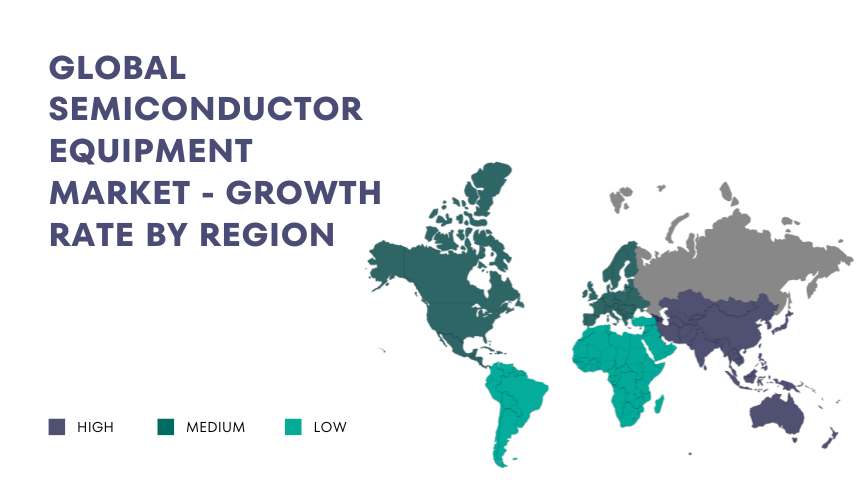
Source: Global Semiconductor Equipment Market – Growth Rate by Region.
Challenges and Issues in the Semiconductor Supply Chain
Over the past few years, semiconductor supply chain dynamics have shifted as a number of vulnerabilities have disrupted production and halted the international trade of these components.
Here are a few of the most pressing challenges that have impacted the semiconductor supply chain in recent years:
- Demand-Supply Imbalance: Although experts predict that the demand for semiconductors will dramatically increase over the coming years, it’s challenging to produce accurate figures. The semiconductor industry regularly experiences imbalances between the global supply and demand, with one outweighing the other. With changing technologies, varying geopolitical tensions, and market volatility, this can lead to major shortages and production delays.
- Natural Disasters: Several of the world’s leading countries for semiconductor production are also at risk of major natural disasters. An example of this in action comes from 2021 when Samsung and NXP semiconductor factories shut down in Austin, Texas, due to Winter storms. This event cost the businesses over $100 million in revenue.
- COVID-19: COVID-19 impacted the global supply chain, frustrating the movement of goods and delaying shipments for months at a time. This was no different in the semiconductor supply chain, with factory workers being unable to travel to work. The shortage of semiconductors this caused impacted over 169 industries and heavily reduced the ability of companies to meet demand.
The challenge of securing semiconductor equipment, raw materials, and the manpower needed to ensure the continual production of these components is becoming increasingly complex. Yet, businesses that understand these issues are able to take proactive measures to navigate these challenges.
Proactive Measures to Navigate Semiconductor Supply Challenges
As supply chain dynamics continue to shift and change, businesses are more readily adapting their strategies to face potential challenges. After a few difficult years of trade, much in part due to COVID and its lasting impression, companies are now incorporating proactive solutions to common challenges.
Here are industry solutions that many semiconductor businesses are turning to in order to reduce the likelihood of disruptions:
- AI Prediction Tools: The increasing presence of AI isn’t only increasing the demand for semiconductors. On the contrary, the semiconductor industry is beginning to use AI software’s superior data prediction capabilities to better predict potential demand trends. By analysing vast quantities of data in seconds, AI can accurately produce demand figures for semiconductor businesses to use
- Supplier Diversification: In order to increase the resilience of the global semiconductor supply chain, businesses are diversifying their suppliers. Establishing a wide net of potential production and distribution sites and centers will help to minimise the potential for natural disasters or unforeseen circumstances to disrupt the industry.
- Semiconductor Supply Chain Agility: Businesses are increasingly attempting to build agility into their supply chains. Instead of creating single points of failure where a handful of factories produce the majority of semiconductors, organisations are dispersing their inventory production and storage facilities around the globe. By establishing a robust communication system with suppliers, businesses can get ahead of potential disruptions and reduce the impact of major world events.
Alongside these proactive shifts, the industry is also experiencing a rapid change in the strategies that semiconductor supply chains employ.
Organisations are increasingly aiming to boost visibility, conduct extensive risk contingency planning, digitise factories, and diversify their manufacturing locations to contribute to a healthier global supply chain.
The Future of Semiconductor Supply Chains
As smartphone and other IoT device usage continue to grow, the semiconductor industry will only continue to cement itself as a world-leading industry.
Over the next ten years, the industry will at least double in market volume. As semiconductors are central to the functionality of many of our most important technological designs, the rising penetration of digital technologies across the globe will only serve to bolster this industry.
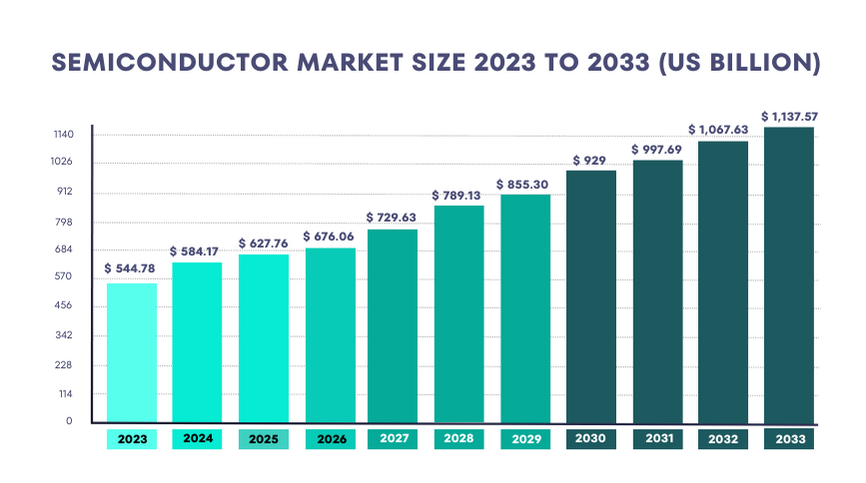
Source: Semiconductor Market Size 2023-2033 (US BILLION).
Another important factor that is expanding the realm of possibilities for the semiconductor market is the increased collaboration between countries. In March 2023, the USA signed a Memorandum of Understanding (MoU) with India to develop a commercial innovation partnership.
Collaborative efforts like these will expand development zones across the world and forge new opportunities that help fulfil the growing demand for semiconductors.
Final Thoughts: The Bright Future of Semiconductor Supply Chains
Despite challenges in demand monitoring, political instability, and global disruption, the semiconductor supply chain industry is entering its golden age. The development and advancement of core technologies like AI allow organisations to plan more precisely for future demand.
Yet, to sustain and achieve the growth that experts forecast in this industry, organisations must stay ahead of the ever-evolving semiconductor landscape. Participating in trend analysis and adapting to emerging shifts is vital for sustained success.
Prewave utilises cutting-edge AI tools to provide world-class supply chain mapping for the semiconductor industry. This technology effortlessly creates supply chain maps that enable businesses to gain full visibility over the semiconductor supply chain and optimise their processes. The integration of real-time alerts furthers the transparency of supply chain operations, minimises potential delays, and allows for rapid response to disruptions.
Leverage Prewave to build a more resilient supply chain, stay ahead of competitors, and navigate emerging challenges in the semiconductor industry.



